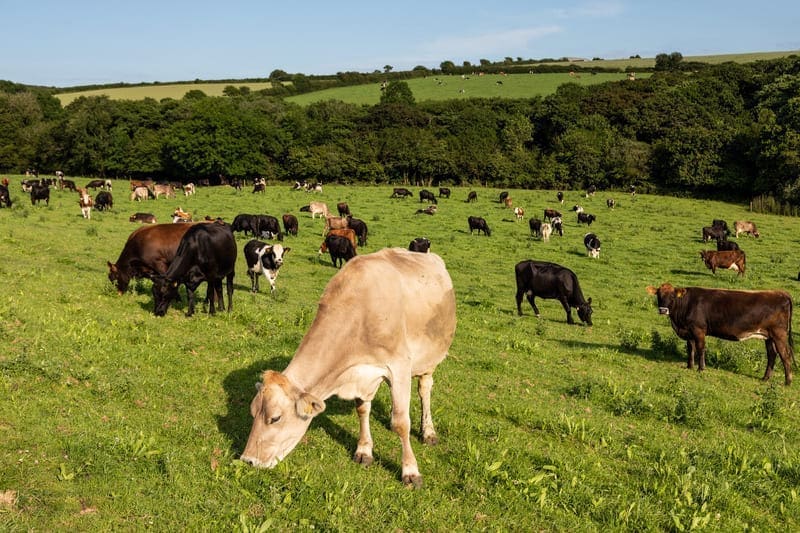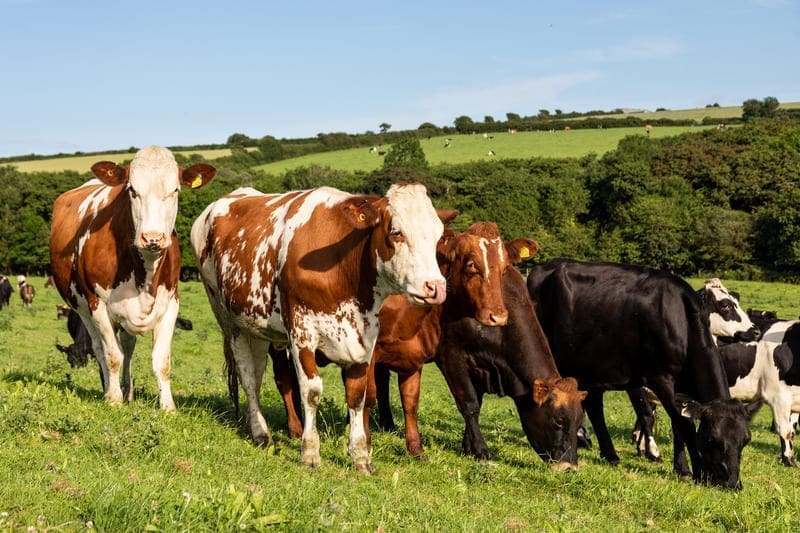Ever since the Clarke family started dairy farming, back in 1976, they were driven by the goal of crafting of delicious dairy products, whilst also caring deeply about the land and the local area.
Forty-five years later, we’re still obsessed with creating healthy pastures to nurture the soil under our cows hooves, we care deeply about the welfare of our herds and we’d do anything to encourage bumblebees and butterflies.
We believe that with great dairy comes great responsibility, so we created the ‘Trew Farming Philosophy’ and Trew Standards which is a code of our shared practices and beliefs.
Building upon these Trew Standards, we also work closely with two farms who have adopted regenerative farming techniques. This has two main outcomes – it sequesters carbon into the soil, and increases biodiversity.
We call this our Earth Milk Project.
We’re using fresh ideas and practical action together with our farmers to make dairy work for the earth. Here’s how;
Pillars of regenerative farming
Soil cover –
Maintaining permanent soil cover, either by growing plants or by plant residue. This protects the soil from erosion by wind, water, and water loss, and provides habitat for soil fauna.
Reduced tillage –
Reducing deep ploughing protects the valuable network of fungal hyphae and improves soil structure, drainage and water holding capacity.
Increased diversity –
Both above and below ground. We plant a carefully selected mix of perennials that not only feed cows the perfect blend of nutrients, it also nourishes the soil itself with a greater diversity of bacteria and fungi. A biologically active soil can be much more productive than one reliant on chemicals. Each 1% of increased soil organic matter helps to retain gallons more water per acre. And increased water holding capability means less nutrient run-off, greater carbon capture, resilient crops and improved soil structure.
Livestock integration –
Improves the cycling of nutrients and water through the system, inoculates the soil with beneficial bacteria and tramples fresh biomass into the soil as a source of nutrients to soil biota.
Grow crops suitable to climate and market –
The south west of the UK has a very mild and forgiving climate from an agricultural point of view. This means it naturally lends itself to growing crops based on grasses, herbs and forages that can be grazed by ruminants.

Benefits of regenerative farming
Carbon capture –
Improving soil health locks in more carbon. The deeper and more complex the root systems, the more carbon we lock away.
Wildlife and biodiversity –
Worms, bees and butterflies are good markers for happy soil and productive land. Some fly above the crop, some live in the grasses, some on the soil surface and others below. As regenerative agriculture calls for less intervention, it encourages an environment for insects who are tiny helpers for farmers.
Earthworms, for one, burrow through the soil, munching as they go, gently churning up the earth. This moves nutrients around and creates channels for root growth, which helps increase the soil’s water-holding capacity.
Above ground, having a diverse range of perennials attracts butterflies, grasshoppers, ants and bees, who all aid pollination.
Nutrient dense milk –
When plants have the root systems they need to flourish, they build compounds to protect against disease and bugs. A fertile soil is full of good bacteria, fungi and nematodes – and the healthier the soil, the healthier the crop. When cows are able to graze on nutrient dense pastures, they’re bound to produce a better quality milk.
What else we have explored
Reducing carbon footprint –
All of our farmers are committed to measuring and reducing their carbon footprint.
Generating clean energy –
As we use a lot of power in our Lostwithiel dairy, we thought we should harness green energy to lessen our reliance on the grid. We generate up to a third of the dairy’s energy requirement at peak times. This equates to an average of 7-8% of our total demand. We buy all other electricity from the grid and this is all green energy.
Grazed herds –
All of our cows graze in the pastures for at least 120 days per year. When conditions aren’t right for the herd to be outside, they are fed locally grown forages.
Recycling –
All our milk bottles, caps and labels are 100% recyclable. The more we can get back into the recycle system, the more we can reuse. As part of our aim as a business to use less plastic, that’s why our bottles are now 15% lighter than before. That means 15% less plastic. Help us reduce and recycle.
Waste management –
We recognise our responsibility to adopt a robust environmental waste management plan. We have been a zero to landfill company since 2020.
Bee project –
We are involved in a project to help safeguard declining wild bee populations. The project aims to restore habitats and link isolated populations, through the creation of flower-rich ‘stepping stones’ and habitat corridors throughout the Fowey Valley and beyond.
Through our Earth Milk project, we aim to become carbon neutral and climate positive. To stay up to date with this journey, subscribe to our newsletters and follow us on social media and we’ll keep you posted as the project develops.
